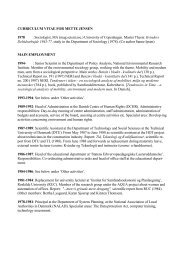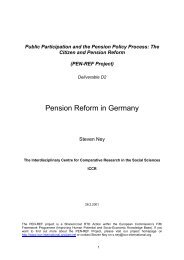The Housing Dimension of Welfare Reform - the ICCR
The Housing Dimension of Welfare Reform - the ICCR
The Housing Dimension of Welfare Reform - the ICCR
Create successful ePaper yourself
Turn your PDF publications into a flip-book with our unique Google optimized e-Paper software.
Social tenants may purchase <strong>the</strong>ir housing unit only if <strong>the</strong> social<br />
designation period has expired. Tenant participation in administration <strong>of</strong><br />
social housing is typically only found in units <strong>of</strong> <strong>the</strong> non-pr<strong>of</strong>it building<br />
associations.<br />
Harmonising trends<br />
European housing policies are characterised by some general<br />
harmonising trends despite persisting differences in orientation. Two<br />
stand out:<br />
<strong>The</strong> first comprises <strong>the</strong> fine-tuning <strong>of</strong> housing policies to reach out more<br />
effectively to <strong>the</strong> needs <strong>of</strong> vulnerable groups. Besides (income)<br />
restrictions imposed on eligibility criteria, especially with regard to social<br />
housing and direct housing allowances, several state and/or regional<br />
housing policies prioritise some groups over o<strong>the</strong>rs in terms <strong>of</strong> coverage.<br />
<strong>The</strong> young, <strong>the</strong> aged, persons with disabilities as well as young and/or<br />
large families are prioritised in several countries. <strong>The</strong> housing needs <strong>of</strong><br />
single mo<strong>the</strong>rs, <strong>the</strong> homeless, battered women and drug users continue to<br />
be mainly <strong>the</strong> remit <strong>of</strong> voluntary or non-governmental organisations or <strong>of</strong><br />
special initiatives.<br />
Secondly, in some countries first attempts are being made to better relate<br />
housing policies to o<strong>the</strong>r policies, and in particular urban regeneration<br />
plans. Exemplary <strong>of</strong> this orientation has been <strong>the</strong> Danish ‘urban renewal’<br />
initiative (1994 to 2002) which besides foreseeing more generous<br />
subsidies for urban social housing tenants, sought to systematically<br />
address problems in social housing estates (see also section 3.4). <strong>The</strong><br />
programme aimed at improving living conditions for deprived tenants<br />
and immigrants through a ‘local network strategy’ and at improving <strong>the</strong><br />
competitiveness <strong>of</strong> problematic estates to attract residents o<strong>the</strong>r than<br />
vulnerable groups. Similar albeit not as extensive local initiatives in Italy<br />
have been emphasising <strong>the</strong> role <strong>of</strong> mediation whilst inserting<br />
disadvantaged groups into <strong>the</strong> housing market in order to avoid ensuing<br />
segregation and stigmatisation. This is also <strong>the</strong> explicit task <strong>of</strong> <strong>the</strong><br />
privately managed non-pr<strong>of</strong>it agencies known as ‘social rental agencies’<br />
or ‘social agencies’ <strong>of</strong>ten established with <strong>the</strong> support <strong>of</strong> municipalities<br />
or local funding. Such agencies exist in Belgium, Italy, Ireland and<br />
Germany and are in charge <strong>of</strong> facilitating <strong>the</strong> housing <strong>of</strong> <strong>the</strong> placement <strong>of</strong><br />
<strong>the</strong> marginalized in <strong>the</strong> housing sector.<br />
3.3.2 <strong>Housing</strong> situation<br />
<strong>The</strong> European Community Household Panel (ECHP) provides a useful<br />
basis for obtaining comparative data on <strong>the</strong> housing situation in Europe<br />
EUROHOME-IMPACT FINAL REPORT 29









